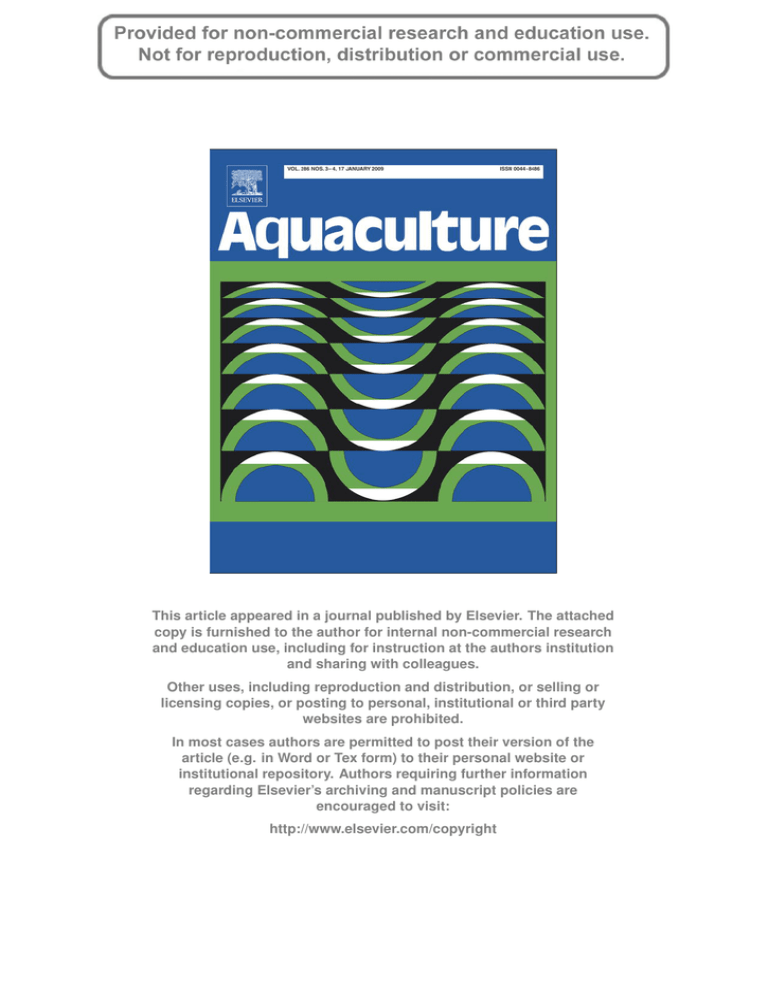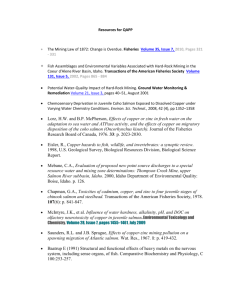This article appeared in a journal published by Elsevier. The... copy is furnished to the author for internal non-commercial research
advertisement

This article appeared in a journal published by Elsevier. The attached copy is furnished to the author for internal non-commercial research and education use, including for instruction at the authors institution and sharing with colleagues. Other uses, including reproduction and distribution, or selling or licensing copies, or posting to personal, institutional or third party websites are prohibited. In most cases authors are permitted to post their version of the article (e.g. in Word or Tex form) to their personal website or institutional repository. Authors requiring further information regarding Elsevier’s archiving and manuscript policies are encouraged to visit: http://www.elsevier.com/copyright Author's personal copy Aquaculture 286 (2009) 154–155 Contents lists available at ScienceDirect Aquaculture j o u r n a l h o m e p a g e : w w w. e l s ev i e r. c o m / l o c a t e / a q u a - o n l i n e Letter to the Editor Comment on Beamish et al. (2007) “A proposed life history strategy for the salmon louse, Lepeophtheirus salmonis in the subarctic Pacific” L.M. Dill ⁎, C.J.C. Losos, B.M. Connors, P. Mages Behavioural Ecology Research Group, Department of Biological Sciences, Simon Fraser University, Burnaby, BC, Canada V5A 1S6 a r t i c l e i n f o Article history: Received 30 July 2008 Received in revised form 21 September 2008 Accepted 22 September 2008 A marine parasite on an anadromous host has a unique transmission challenge. It must infect a subsequent generation (or an alternate host species) prior to its current host's entry into freshwater, where the parasite (and often its host) will die. The salmon louse, a salmonidspecific parasite, faces just such a problem, and we would expect this species to have evolved a strategy to maximize transmission during the limited window of opportunity when incoming adults and outmigrating juveniles (or alternate hosts) are present in an area simultaneously. In their 2007 paper “A proposed life history strategy for the salmon louse, Lepeophtheirus salmonis in the subarctic Pacific”, Beamish et al. (hereafter BEA) hypothesize a strategy enabling sea lice to solve this problem. The data in this paper are interesting in showing that adult Pacific salmon carry salmon lice into the coastal environment during their migration and overlap with juveniles in the late summer (August). Although these data confirm anecdotal evidence of the presence of sea lice on adult salmon in the marine coastal environment, something known to all fishermen, we argue that BEA's hypothesis is fundamentally flawed and their paper invites misleading citation. BEA use incorrect terminology and vague definitions, and omit important literature while arriving at highly speculative and, in our opinion, inappropriate conclusions. While natural selection has undoubtedly shaped the life history strategy of L. salmonis BEA claim that “the transport of sea lice into coastal areas is a strategy employed by L. salmonis to improve their productivity….” There are several fundamental problems with this statement. The term “life history strategy” refers to the allocation of individual resources to competing life functions (see, e.g., Winemiller and Rose, 1992), something which inevitably involves trade-offs, for example between growth and reproduction. BEA fail to identify any such trade-offs and provide no support for their assertion that this ⁎ Corresponding author. E-mail address: ldill@sfu.ca (L.M. Dill). 0044-8486/$ – see front matter © 2008 Elsevier B.V. All rights reserved. doi:10.1016/j.aquaculture.2008.09.024 attribute of the louse life history is the result of selection. Indeed, “transport” per se cannot be a strategy or an adaptation—in fact, it may be more reasonable to assume that this is simply a consequence of parasitizing a migratory host. Only if it were shown, for example, that lice delayed their production of offspring until host cohorts overlapped, so as to maximize transmission, would it be proper to speak of a strategy. BEA show that lice-infested adults are sympatric with “juvenile” pink (Oncorhynchus gorbuscha) and chum (Oncorhynchus keta) salmon in “coastal” areas in August. While it is reasonable to assume that inter-generational transfer of lice may occur then, and this has been shown by other studies (Krkosek et al., 2007), this cannot explain how juvenile pink and chum salmon fry entering the marine environment much earlier in the spring (March–early April) become infested with lice, as these adults would not be present. As a result of the summer bias in their data, there is no reasonable way the authors can make the generalization that “some juvenile Pacific salmon would be infected by resident salmon almost immediately after they entered the ocean”. No data are provided to support this vague claim, and other studies (discussed below) repeatedly show that lice prevalence and abundance on newly emerged fry are in fact very low. To deal with this problem, BEA postulate that “Infected juvenile salmon would also carry the parasite over winter in coastal areas where the offspring of these sea lice can infect juvenile Pacific salmon when they enter the ocean in the spring,” but once again provide no data to support this. The authors claim “that large abundances of juvenile Pacific salmon coexist with these returning adult Pacific salmon. Most of these juvenile salmon will migrate into the open ocean, but MANY (emphasis ours) coho (Oncorhynchus kisutch) and chinook (Oncorhynchus tshawytscha) remain in the coastal areas during winter.” BEA base this statement on a sample of 10 coho and 25 chum salmon captured in April–May in a very large area “in the vicinity of Broughton Island and in Knight and Kingcome Inlets”. Without knowledge of the region, a naïve reader could not know that this spans from natal streams, all the way to the Queen Charlotte Author's personal copy Letter to the Editor Strait–across both “nearshore” and “coastal” ecosystems, as defined by the authors–and encompasses several hundred square kilometers. A sample size of 35 fish during 2 months in a single year does not easily allow for confident generalizations, especially over such a large area with such vague descriptions. From this information, one cannot determine whether the fish were captured in coastal or nearshore areas—critical information to BEA's interpretation. Also of note is that species and stage of lice were not determined for these fish, which is of key importance in determining their origin and role in the transmission dynamics of the parasite. Most importantly, high levels of infestation on very young fish in the eastern Pacific have been reported only in areas with extensive salmon aquaculture, such as the Broughton Archipelago (Morton and Williams, 2004; Morton et al., 2004, 2005; Krkosek et al., 2005, 2006). The existing literature on juvenile Pacific salmon in the nearshore environment points to very low infestation rates in the first months after seawater entry in areas without salmon farms. BEA refer to the work of Wertheimer et al. (2003) as evidence to support infection of salmon in areas without farms. However, BEA fail to mention any of the life stages sampled by these authors, and they conveniently omit the data presented by Wertheimer et al. on juvenile chum salmon reared in seawater netpens in littoral areas for as many as 93 days prior to release (May–early June) without any sign of infection. In late June, when juvenile salmon were first encountered in neritic waters (the equivalent of BEA's “coastal” waters), no evidence of infection was observed on juvenile pink and chum salmon. It was not until July that sea lice were observed on juvenile pink and chum salmon (at a prevalence of 4.6% and 10.1%, respectively) concurrent with the return and mixing of infected adults of the same species. A study performed in B.C. found no evidence of infestation on juvenile pink and chum salmon in either Smith (June to July) or Rivers (mid May to July) Inlets (Morton et al., 2004). In the same study, very low lice abundance was found in samples obtained near Prince Rupert (2 L. salmonis on 566 individuals, May to June). None of these locations contain fish farms. In addition, a three-year sampling program in Chatham Sound on the north coast of British Columbia has documented very low abundance of L. salmonis on juvenile pink and chum salmon during April, May and June (Krkosek et al., 2007). It is not until July, when returning adult chinook salmon occur in sympatry with juvenile pink salmon, that L. salmonis prevalence rises (from 2–3% to 50%). The important point in these findings, and the one that argues most strongly against BEA's hypothesis, is that if the route of transmission to juvenile salmon results from a naturally evolved strategy, then the same patterns of infection should be seen coast-wide. However, such patterns are seen only in the vicinity of fish farms. Although it is likely that some low-level transmission to newly emerged salmon occurs from overwintering wild Pacific sub-adults, these numbers must be dwarfed by the millions of farmed Atlantic salmon present in the Broughton Archipelago, carrying infective lice, as juvenile salmon migrate past them on their way out to sea (Orr, 2007). These farms have been identified as point sources of sea louse infection on juvenile pink and chum salmon (Krkosek et al., 2005, 2006). Farmed salmon have similarly been implicated as a source of infection for wild fish elsewhere (Tully and Whelan, 1993; Tully et al., 1999; Bjørn et al., 2001; Bjørn and Finstad, 2002; Butler, 2002; Heuch et al., 2005). BEA's paper is curious in failing to mention these farm 155 hosts in the Broughton Archipelago, despite this being the only place on the coast where newly emerged wild fry are heavily parasitized. In summary, BEA's errors of omission and their selective use of their own and others' data lead the naïve reader to a conclusion that cannot be substantiated. Their “conclusion” that the “transport of L. salmonis into coastal areas is an evolutionary adaptation” is unwarranted and, indeed, is not a conclusion at all. In fact, the presence of farmed salmon along the migration routes of very young wild salmon represents an anthropogenic perturbation to a natural host–parasite system that arguably makes it impossible to study the parasite's evolved “strategy”, despite the authors' claim that their study is intended to provide “an understanding of the natural production of sea lice.” References Beamish, R.J., Neville, C.M., Sweeting, R.M., Jones, S.R.M., Ambers, N., Gordon, E.K., Hunter, K.L., McDonald, T.M., 2007. A proposed life history strategy for the salmon louse, Lepeophtheirus salmonis in the subarctic Pacific. Aquaculture 264, 428–440. Bjørn, P.A., Finstad, B., 2002. Salmon lice, Lepeophtheirus salmonis (Kroyer), infestation in sympatric populations of Artic char, Salvelinus alpinus (L.), and sea trout, Salmo trutta (L.), in areas near and distant from salmon farms. ICES J. Mar. Sci. 59, 131–139. Bjørn, P.A., Finstad, B., Kristofferson, R., 2001. Salmon lice infection of wild sea trout and Arctic char in marine and freshwaters: the effects of salmon farms. Aquac. Res. 32, 947–962. Butler, J.R.A., 2002. Wild salmonids and sea louse infestations on the west coast of Scotland: sources of infestation and implications for the management of marine salmon farms. Pest Manag. Sci. 58, 595–608. Heuch, P.A., Bjørn, P.A., Finstad, B., Holst, J.C., Asplin, L., Nilsen, F., 2005. A review of the Norwegian action plan against salmon lice on salmonids: the effects on wild salmonids. Aquaculture 246, 79–92. Krkosek, M., Lewis, M.A., Volpe, J.P., 2005. Transmission dynamics of parasitic sea lice from farm to wild salmon. Proc. R. Soc. Lond., B 272, 689–696. Krkosek, M., Lewis, M.A., Morton, A., Frazer, L.N., Volpe, J.P., 2006. Epizootics of wild fish induced by farm fish. Proc. Natl. Acad. Sci. U. S. A. 103, 15506–15510. Krkosek, M., Gottesfeld, A., Proctor, B., Rolston, D., Carr-Harris, C., Lewis, M.A., 2007. Effects of host migration, diversity, and aquaculture on disease threats to wild fish populations. Proc. R. Soc. Lond., B 274, 3141–3149. Morton, A.B., Williams, R., 2004. First report of a sea louse, Lepeophtheirus salmonis, infestation on juvenile pink salmon, Oncorhynchus gorbuscha, in nearshore habitat. Can. Field-Nat. 117, 634–641. Morton, A., Routledge, R., Peet, C., Ladwig, A., 2004. Sea lice (Lepeophtheirus salmonis) infection rates on juvenile pink (Oncorhynchus gorbuscha) and chum (Oncorhynchus keta) salmon in the nearshore marine environment of British Columbia, Canada. Can. J. Fish. Aquat. Sci. 61, 147–157. Morton, A., Routledge, R.D., Williams, R., 2005. Temporal patterns of sea louse infestation on wild Pacific salmon in relation to the fallowing of Atlantic salmon farms. North Am. J. Fish. Manage. 25, 811–821. Orr, C., 2007. Estimated sea louse egg production from Marine Harvest Canada farmed Atlantic salmon in the Broughton Archipelago, British Columbia, 2003–2004. North Am. J. Fish. Manage. 27, 187–197. Tully, O., Whelan, K.F., 1993. Production of nauplii of Lepeophtheirus salmonis (Krøyer) (Copepoda: Caligidae) from farmed and wild salmon and its relation to the infestation of wild sea trout (Salmo trutta L.) off the west coast of Ireland in 1991. Fish. Res. 17, 187–200. Tully, O., Gargan, P., Poole, W.R., Whelan, K.F., 1999. Spatial and temporal variation in the infestation of sea trout (Salmo trutta L.) by the caligid copepod Lepeophtheirus salmonis (Krøyer) in relation to sources of infestation in Ireland. Parasitology 119, 41–51. Wertheimer, A.C., Fergusson, E.A., Focht, R.L., Heard, W.R., Orsi, J.A., Sturdevant, M.V., Wing, B.L., 2003. Sea lice infection of juvenile salmon in the marine waters of the northern region of south-eastern Alaska, May–Aug 2003. N. Pac. Anadr. Fish Comm. Doc. 706, Auke Bay Lab., Alaska Fisheries Science Center, National Marine Fisheries Service, NOAA, U.S. Dept. of Commerce, 11305 Glacier Highway, Juneau Alaska, 99801-8626, 13 pp. Winemiller, K.O., Rose, K.A., 1992. Patterns of life-history diversification in North American fishes: implications for population regulation. Can. J. Fish. Aquat. Sci. 49, 2196–2218.





